As an Amazon Associate I earn from qualifying purchases.
Everyone wants to learn how to make ceviche, and, while ceviche recipes are all over the place, a basic ceviche is, more or less, pico de gallo with fish or seafood in it.
Ceviche is one of those seemingly esoteric dishes that Americans have truly embraced, especially those of us who live fairly near the ocean. A Peruvian invention, the original ceviche recipe is fish or seafood marinated in citrus juices, which then “cook” the fish. I’ve seen all sorts of versions served in restaurants, and if you look on any angler’s forum you’ll see recipes for ceviche of… well anything, really.
This can be a very bad idea.
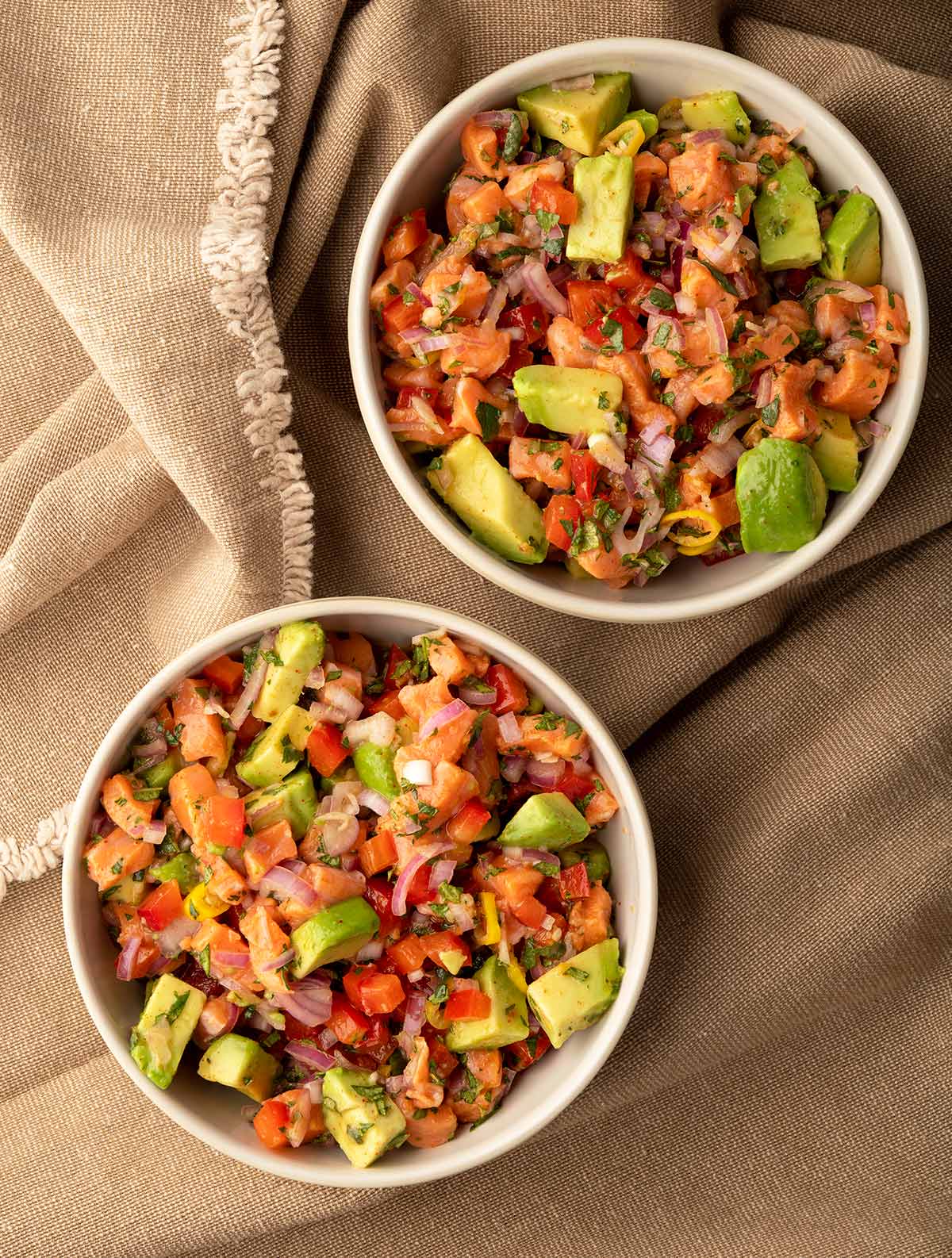
The reason is because ceviche (sev-ee-chay) is still, for the most part, a raw fish dish.
The citrus bath the fish or seafood sits in does turn the meat opaque, giving it the appearance of being cooked, and it does kill some of the many wee beasties present in raw foods that can make you sick, notably the toxin vibrio. But the ceviche-making process will not protect you from the worst of the nasties, ranging from salmonella to parasites and worms.
Certain species of fish tend to be more or less prone to parasites. So the best fish for ceviche are those you would see at a trip to the sushi bar. Tuna and other pelagic species tend to be free of parasites (swordfish being a notable exception), as is farmed salmon (oddly). But ever notice that mackerel (saba) is always cured?
That’s because it can often contain anasakis worm larvae, also known as seal worm. Everything in the cod family is especially prone to infestation, too, which is why you never see cod sushi.
Here in the West, Pacific salmon, rockfish and halibut well known to harbor anasakis larvae, and to be safe you must freeze your fish before eating it raw. And when I mean freezing I mean really freezing. You need the fish to hit -4°F for about a week to do the trick. Note that older home freezers never hit this temperature.
(If you want to learn more on this topic, we did an entire podcast episode on parasites in fish.)
I don’t want to scare you too much. The vast majority of illnesses you might get from eating tainted or parasite-laden raw fish will be moderate to light. It’ll feel like food poisoning, with cramps, nausea and a serious case of the trots. Not fun, but not life-threatening, either. This is because in most cases we are not what’s called a “definitive” host, meaning the parasite hits a dead end with us.
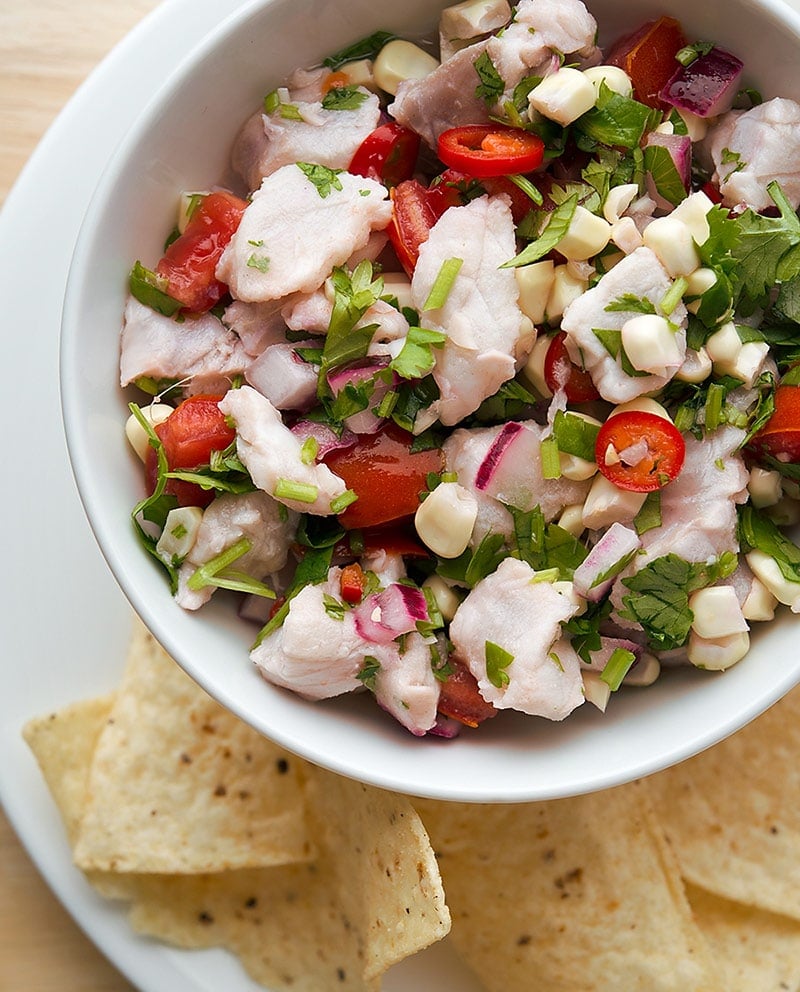
Seal worm is a great example. The seal worm (anasakis) is around wherever there are seals and sea lions — they are the “definitive” host for that parasite. When we eat raw, tainted salmon, the worm says, “Cool! A mammal! Let’s attach to his intestines.” But the worm soon learns that a person is not a sea lion and it dies, but not before making you sick.
We are a definitive host to lovely critters like liver flukes and tapeworm, however, which are common in North American freshwater fish. The single largest vector for tapeworm in America is from people eating raw or undercooked trout. People think, “Hey! I love salmon sushi, and trout is just a cousin of a salmon, so…”
Bad idea. Under no circumstances should you eat freshwater fish raw or in ceviche that has not been properly frozen first. Remember the only way to get rid of a tapeworm, which can grow longer than 20 feet in your guts (nasty!) — is to take medicine that will kill it. You then need to eject the thing. Ew.
Now that I’ve freaked you all out, here’s some good news: Actual illness from parasites and such is pretty rare. I’ve known guys who’ve eaten fresh raw salmon for years without getting sick, and raw Pacific salmon is one of the fish with the highest incidence of tapeworm and seal worm infestation.
What’s more, you can vastly improve your chances of avoiding parasites in your fish by killing the fish quickly when it comes overboard, bleeding it, and gutting it ASAP. This last bit is the most important because virtually all the parasites hang out in the viscera of fish, not the meat. In most cases, the meat gets tainted because when the fish dies the parasites panic and burrow into the meat.
Here is an overview of seafood safety from the Centers for Disease Control and Prevention.
Bottom Line: Unless you are tuna fishing, make your ceviche from pre-frozen fish. It’s just a smart thing to do.
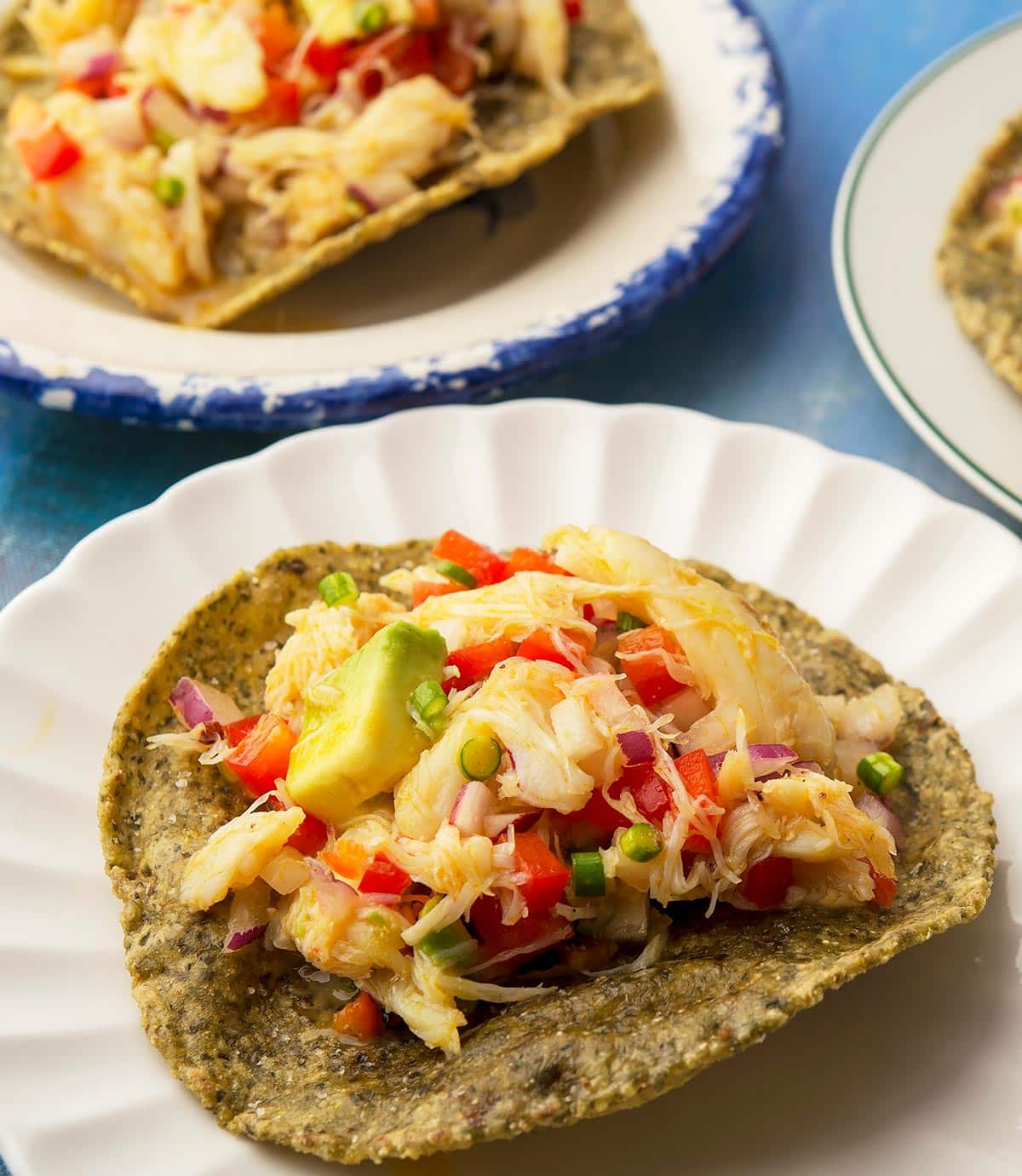
Once it’s been properly frozen, however, the sky’s the limit. A traditional Peruvian ceviche recipe typically has onions, chiles, cilantro and sometimes corn and tomatoes. I normally go that route and serve an appetizer-style ceviche that’s great eaten on tortilla chips. Fantastic for a light dinner, or to put out when you are watching football or having a party.
I have variations on how to make ceviche that range all over the Latin American world, from a Chilean salmon ceviche, to Mexican crab ceviche tostadas, and even a ceviche de calamar, with squid.
Marinating times make a difference when you are making ceviche. Depending on the size of the fish pieces, you will need at least 30 minutes and normally an hour for the citrus to “cook” the fish. Two hours is fine, but beyond that the ceviche, while still good, becomes more of a pickled fish thing. It’s a subtle difference, but you can taste it.
If you don’t marinate the fish at all, and serve basically a mash-up of sushi and ceviche, you have Mexican aguachile.
Citrus matters, too. You always want the dominant citrus in the marinade to be either limes or lemons, which are far more acidic than oranges, grapefruits or tangerines. Add these fruits as an accent to the ceviche; I am especially fond of a little grapefruit in the mix.
Basic Ceviche
Ingredients
- 1 pound pre-frozen lingcod, rockfish or other lean, white fish
- 3 limes
- 2 lemons
- 1 grapefruit
- Salt and black pepper
- 1/2 red onion, sliced root to tip
- 2 Roma or other paste tomatoes, seeded
- 1 ear of corn, kernels sliced off
- 1 habanero or rocoto chile pepper, or more to taste
- 3 tablespoons chopped cilantro
Instructions
- Slice the fish into small, bite-sized pieces. Cut the tomatoes into pieces the same size as the fish and set them aside for later. Zest 1 lime, 1 lemon and the grapefruit and grate them fine; I use a microplane grater to do this. Mince the habanero fine. Juice all the citrus. Add all the ingredients except for the tomatoes and the cilantro to a bowl or plastic container with a lid and refrigerate for 30 minutes to 2 hours.
- Add the tomatoes and cilantro, mix well and serve cold with chips.
Video
Nutrition
Nutrition information is automatically calculated, so should only be used as an approximation.
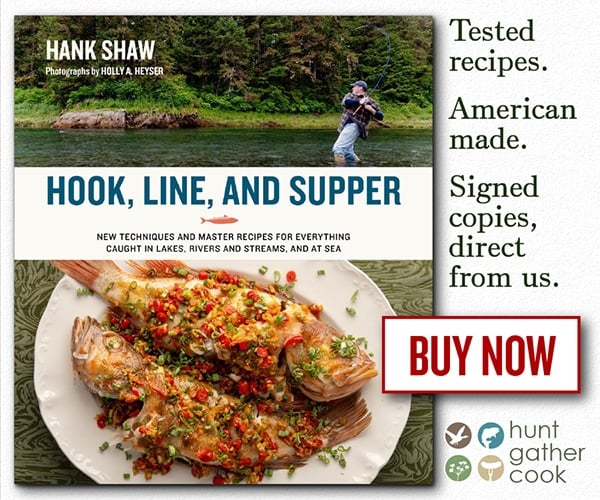

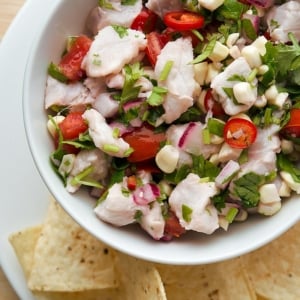

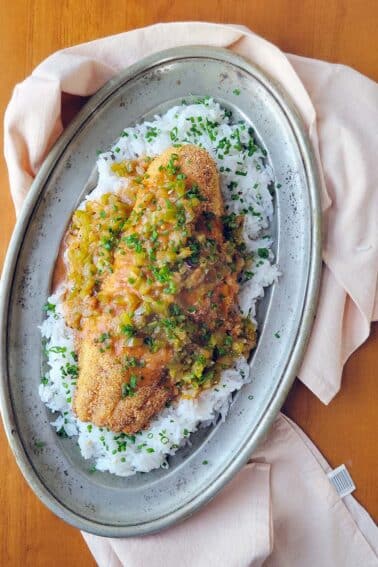
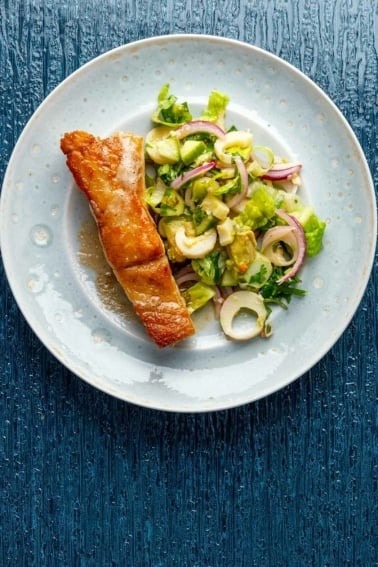
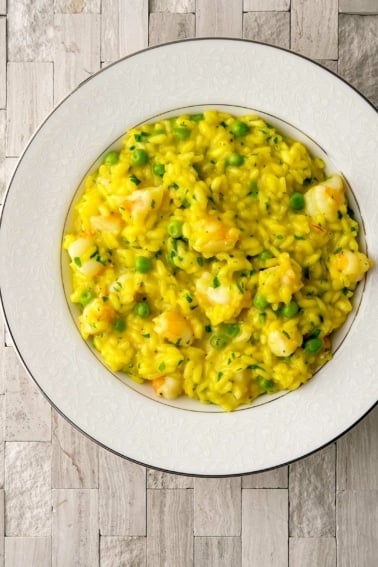
Wondering about fresh caught mahi for ceviche without freezing it . Been doing it forever after my fishing trips successfully but wondering about it now.
Also been eating red snapper sashimi without freezing for some time. What is your recommendation on that one?
James: Mahi seems to be safe, from what I’ve read. Not 100% sure of that, but I’ve made ceviche from it a lot without freezing.
In the article you say: “You always want the dominant citrus in the marinade to be either limes or lemons, which are far more acidic than oranges, grapefruits or tangerines”. But the recipe calls for 3 limes and one lemon and one grapefruit. Since the grapefruit is so much larger than limes or lemons, when I do it I get more grapefruit juice (and zest) than lime + lemon. Should I not use all the grapefruit juice and zest?
Also, I catch landlocked striped bass. Are they more or less likely to have parasites than those that spend time in the ocean?
Mark: You’ll be fine with that mix. I’ve used it for many years. As for striped bass, yes, they are parasitized quite a lot. Definitely freeze before eating raw.
How long would fish need to be frozen in a “regular” home freezer to be considered safe to eat? Or would it never be safe?
I’m specifically talking about crappie that I catch from freshwater lakes and rivers.
Randall: Depends. Those temps are achievable with many regular freezers. But you are right in guessing that unless it hits that temp, it’s not technically safe.
Tilapia is the most common fish in ceviche around my neck of the woods, usually having tilapia, shrimp, and scallops, with onion, tomato, some kind of pepper/chile, and cillantro.
Thanks for the safety pointers. Is fresh black cod ok for ceviche or better used frozen?
TeCook: I would freeze it first. It’s a bottom dweller.
Question! If it has been properly pre-frozen, do you thaw it out before cutting it up and using? Or do you need to cut it up frozen and then put it in the marinade?
Thanks!
Aimee: Either work. I like to let the fish semi thaw so I can cut it smaller and more evenly.
This was a well researched topic and I can appreciate it for myself, not a ceviche lover, and for those who are. I’ve never been a fan of ceviche, widely available in Mexico. I’ve never been a fan of poke, Hawiaian ceviche, either. There are so many wonderful foods to create from, and so many things on the menu, that I dont risk it. I’ve always wondered about restaurant standards coming into play, so never ate enough of the stuff to get hooked. Fishing pun intended! I’d probably try it again if YOU were serving it directly.
I like catfish for ceviche – it’s firm and doesnt fall apart. And I add sliced green olives, something I picked up in Panama. Their salty taste adds a nice touch! . Frozen shrimp works great and if scallops are on sale I add those, too. Yum! And I like to serve it in a frosted martini glass. It’s going to be 105 degrees here today – perfect ceviche weather..
So when you say “pre-frozen”, could that just be frozen fish in the freezer isle at a grocery store? Or it has to be pre frozen from a butchers shop where the fish is -4 degrees?
Chavarre: Yes, that would count as pre-frozen.
One thing I do and I don’t know if you agree with it but I par boil fish and shrimp for 20 seconds drain and blot out water before I marinate in the lemon and lime. I just feel better about this process…
Beverly: That’s a decent safety measure but to me it ends up marring the flavor. But that’s just a personal decision.
hello. no mention of striped bass from bay?
I have used it before, but now am curious you had no mention of striped bass!
thank you
( made your fish stock with head and all and the chowder!..AMAZING)
oops.. I forgot to mention, I do not freeze the meat.
it gets cleaned fairly soon, and my husband doesn’t use belly meat
Pamela: Striped bass can be quite parasitized, so it needs to be frozen before eating raw. And as I mention in the article, not every fish will have parasites, but this is just to be safe.
Hi! I saw you mention swordfish. If it’s frozen is it safe? Or should I just never be used? Thanks
Alyssa: Pre-frozen it will be safe.
Will cooked shrimp work with ceviche or will it get “tough” when the citrus is added?
Heidi: You can use cooked shrimp, but don’t marinate more than about 30 minutes.
Another brilliant article that answered all of my questions in complete detail. Thanks.
If I buy frozen trout at the supermarket, is that the safest bet?
Mary: Definitely.
“What’s more, you can vastly improve your chances of avoiding parasites in your fish by killing the fish quickly when it comes overboard, bleeding it, and gutting it ASAP. ”
I went on a charter yesterday and came home with lbs of rockfish and lingcod. They were pulled out approx 11am, bled immediately, and filleted on the trip home, so maybe 2-3 hours difference. Is that a good approximation of ASAP?
Erin: Yep.
If I’m buying frozen seafood from a US grocery store, what is my best bet to thaw and use for ceviche? I currently poach my seafood just a bit (blanch, basically) and that makes it feel “safer” but it takes away from the texture.
Lilly: What species? I like snapper a lot for it.
Hey there! Great info. So a question about freezing – is pre frozen store bought cod safe to use then? It said most home freezers will not go low enough to kill of the nasties but do commercial freezers take care of that problem in store bought pre-frozen fish?
Thanks!
Kalila: Commercially frozen fish should have been initially frozen at the proper temperature, then stored in the supermarket at regular freezing temperatures. I have made ceviche from pre-frozen fish a lot, with no problems.
If you do not live close to the ocean or a fishing port, you have no choice but eating frozen fish made ceviche. Your recommendations are good for safety consumption of citrus marinated fish, even though most recipes look more like fish salad to me (sure depends on the style and regions). The real deal is when you prepare ceviche from freshly caught fish, there is huge difference in flavor, it does not even need lot of spices, just salt, freshly squeezed limes, a bed of red onions rings, some hot pepper, garnish of cilantro. That’s it!, we like to accompany it with choclo (Peruvian corn) and/or cooked sweet potato. This is one of the signatures dishes from Peru.
What the freezer doesn’t kill the acid will.
Antonio: That is a myth, actually. The acidity of the citrus has no effect on parasites.
Can I use fresh packet fish from the supermarket that I’ve frozen? It will be easier to slice frozen and then thaw out before marinating?
Minky: yes, if you follow the safe freezing instructions in the article.
I first came across ceviche back in the 90’s whilst on a fishing trip out of Margarita Island, just off the coast of Venezuela.
Walking the coast in the midday sun (sensible), we discovered an old , ramshackle yacht club. I liked it, very Hemingway.
I ordered cold beers and was automatically served a small dish of ceviche . Chilled, highly seasoned and drenched in chile and citrus. We ate it with cocktail sticks and plenty more cold beer, the reason it was being given away.
However, once any food is served in a commercial establishment it is subject to the health and safety laws. All freezers must freeze at -18 C . My freezers here in the Philippines hover around -20 C and as soon as I’ve finished restructuring my bar and garden area there will be ceviche in abundance.
It’s unlikely any seafood will be frozen as I visit the local fish market on a regular basis.
Can you comment on using shrimp or scallops in the ceviche? Thanks
Laura: I’ve never heard of anyone getting sick from fresh scallops, but I do freeze my shrimp before making ceviche with them.